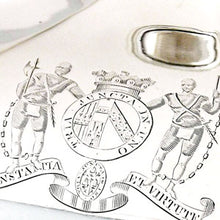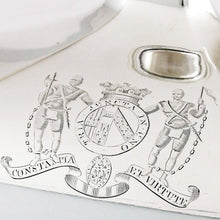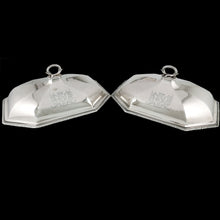Field Marshal Baron Amherst - A Pair of George III Entree Dishes & Covers, 1794
- Regular price
- £9,000
- Sale price
- £9,000
- Regular price
-
- Unit price
- /per
Adding product to your cart
Each overall: 11cm (4.25in) x 27cm (10.5in) x 20.5cm (8in)
Silver. Of elongated octagonal form, the bases with gadroon borders, each engraved with the crest of Field Marshal Amherst surmounted by a Baron’s coronet, the undersides further inscribed ‘No.1’ and 'No.2' respectively; the covers, also marked ‘No.1’ and 'No.2' on the undersides, with looped foliate handles bearing the arms of the Field Marshal impaling those of his second wife Elizabeth, daughter of General the Hon. George Cary. Maker’s mark of R. & T. Makepeace. Hallmarked London 1794.
Read more
Arms - Quarterly, first and fourth, Gules three lances, or tilting spears, erect in fesse, Or, headed, Azure, second quarter, Argent on a fess Azure, three crosses pattee Or, third quarter, Paly of six Or and Gules, on a chief of the last, three escallops of the first, (for Amherst), impaling, Argent, on a bend Sable three roses of the field (for Cary), the whole surrounded by the collar and badge of a Knight Companion of the Bath; for a Crest, on a mount vert, three tilting spears, Or, headed, Argent, one in pale, and two in saltire, environed with a chaplet of laurel, Vert; for Supporters, two Canadian War Indians, of a copper colour, rings in their ears and noses, and bracelets on their wrists and arms, Argent cross-belts over the shoulders, buff; to one powder horn pendent, to the other a scalping knife, their waists covered with a short apron, Gules, gaiters, Azure, seemed, Or, legs fettered and fastened by a chain to bracelet on the outer wrist; the dexter Indian holding, in his exterior hand, a battle axe, the sinister holding, in his exterior hand, tomahawk, thereon a scalp. Motto: ‘Constantia Et Virtute’ (By constancy and virtue).

Field Marshal Jeffery Amherst, 1st Baron Amherst, K.B. (1717-1797) was the architect of Britain's successful campaign to expel the French from North America. In 1758 he led the joint naval and military operation that overcame the formidable defences of the French naval base at Louisbourg. In 1760 he captured Montreal causing half the continent to change hands ‘at the scratch of a pen.’ Settlers in Boston celebrated Amherst’s achievement with a day of thanksgiving, widespread celebration and the firing of cannon. He afterwards became a member of George III's Privy Council, Governor of Guernsey, and one of the highest ranking military officers of his time. More than thirty places around the world bear his name.
The son of a Kentish lawyer, Amherst was born in Sevenoaks and became a page to the Duke of Dorset at an early age. He was commissioned Ensign in the First Foot Guards in 1735 and gained his first military experience during the War of the Austrian Succession (1743-48) fighting the French in Continental Europe and by turns becoming an aide to General John Ligonier and the Duke of Cumberland. During the Seven Years War (1756-63) he commanded Hessian forces against the French invasion of Hanover, and was present in the dispiriting Allied retreat to the North Sea coast. However when William Pitt the Elder and Frederick the Great overturned the Convention of Klosterzeven, Amherst found himself posted to North America and appointed by Pitt to lead a new attempt against the French at Louisbourg.
Amherst duly assembled a joint naval and military force of some 14,000 men and 190 ships at Halifax, Nova Scotia in May 1758. After a period of bad weather he launched his assault from an anchorage some three miles from the French stronghold using a flotilla of large boats. French defences were initially successful and inflicted heavy losses, forcing one of his brigadiers, James Wolfe, to order a retreat. However, at the last moment, a boatload of Roger’s Rangers in Wolfe's division found a rocky inlet protected from French fire and secured a beachhead. Wolfe redirected the rest of his division to follow. Outflanked, the French retreated rapidly into to their fortress.
After eleven days’ toil, the British artillery batteries were in position and opened fire. Within an hour they had destroyed walls and damaged several buildings. A few days later a mortar round set the 74-gun French ship L'Entreprenant ablaze. A stiff breeze fanned the fire and two other French ships began to burn. L'Entreprenant exploded depriving the French of the largest ship in the Louisbourg fleet. The next major blow to French came on the evening of 23 July, at when a British ‘hot shot’ hit the fortress’s headquarters and causing a fire that destroyed what was then the largest building in North America. Using a thick fog as cover, Admiral Boscawen sent a cutting-out party to destroy the French ships in the harbour. The British raiders eliminated the last two French ships of the line, capturing the Bienfaisant and burning the Prudent, thus clearing the way for the Royal Navy to enter the harbour.
In the wake of this action, Amherst was appointed Commander-in-Chief of the British Army in North America and colonel-in-chief of the 60th (Royal American) Regiment. He next led an army against French troops on Lake Champlain, where he captured Fort Ticonderoga in July 1759, while another army under took Niagra also in July 1759 and James Wolfe besieged and eventually captured Quebec with a third army in September. In London the year was celebrated as an Annus Mirabilis, causing Horace Walpole to remark ‘Our bells are worn threadbare with ringing for victories’.Amherst was named Crown Governor of Virginia from 12 September 1759.
In July 1760 Amherst put into execution his three pronged pincer movement to capture Montreal. James Murray led a force of 3,800 men along the St. Lawrence River from Quebec. William Havilland closed with 3,400 from the Richelieu River, while finally Amherst with 11,000 men came by the St. Lawrence from Lake Ontario. To avoid the agony of another long siege the French surrendered. New France fell in the hands of the British thereby ending French rule in North America on 8 September.
In recognition of this victory, Amherst was appointed Governor-General of the British in North America in September 1760 and promoted to Major-General. He was also appointed a Knight of the Bath in early 1761. From his base at New York he oversaw expeditions to the West Indies that led to the British capture of Dominica in 1761 and Martinique and Cuba in 1762.
In 1763 Amherst faced an uprising by Native American tribes in the Ohio Valley and Great Lakes region. His conduct in dealing with it has been condemned by 21st century commentators who have demonised him for his decision to introduce smallpox amongst the tribes by giving infected blankets to Indian emissaries. The evidence demonstrates this was a considered action on Amherst’s part but it also shows that it may have been influenced by the slaughter of all but one of the garrison at Fort Venango a month earlier. The survivor, Lieutenant Francis Gordon, was forced to write a letter detailing why the Indians had risen against the British. He transcribed two complaints: the scarcity of gunpowder for the past two years and the fact that the English, contrary to their promises, were keeping forts, and building new ones, in Indian territory. Lieutenant Gordon was then slowly tortured, roasted to death at the stake, and the fort burnt to the ground.
Amherst was summoned home shortly afterwards, ostensibly so that he could be consulted on future military plans in North America, however, once in London, he was instead asked to account for the recent Native American rebellion and was criticised by military subordinates on both sides of the Atlantic. Nevertheless, Amherst was promoted Lieutenant-General on 26 March 1765, and became colonel of the 3rd Foot. In 1772, he became a member of the Privy Council and four years later was raised to the peerage as Baron Amherst of Holmesdale in the County of Kent. In April 1778, he became Commander-in-Chief of the Forces which gave him a seat in the Cabinet during the American Revolution. Later the same year he was visited by George III and Queen Charlotte at his home, Montreal Park in Kent. With the outbreak of the French Revolutionary War, he was recalled as Commander-in-Chief of the Forces in January 1793, but the failure of the Flanders campaign reflected badly on him and he was succeeded by the Duke of York. Promoted to the rank of Field Marshal on 30 July 1796, Amherst retired to his home Montreal Park with his second wife, Elizabeth née Cary, to reflect no doubt on happier times of the Annus Mirabilis.










